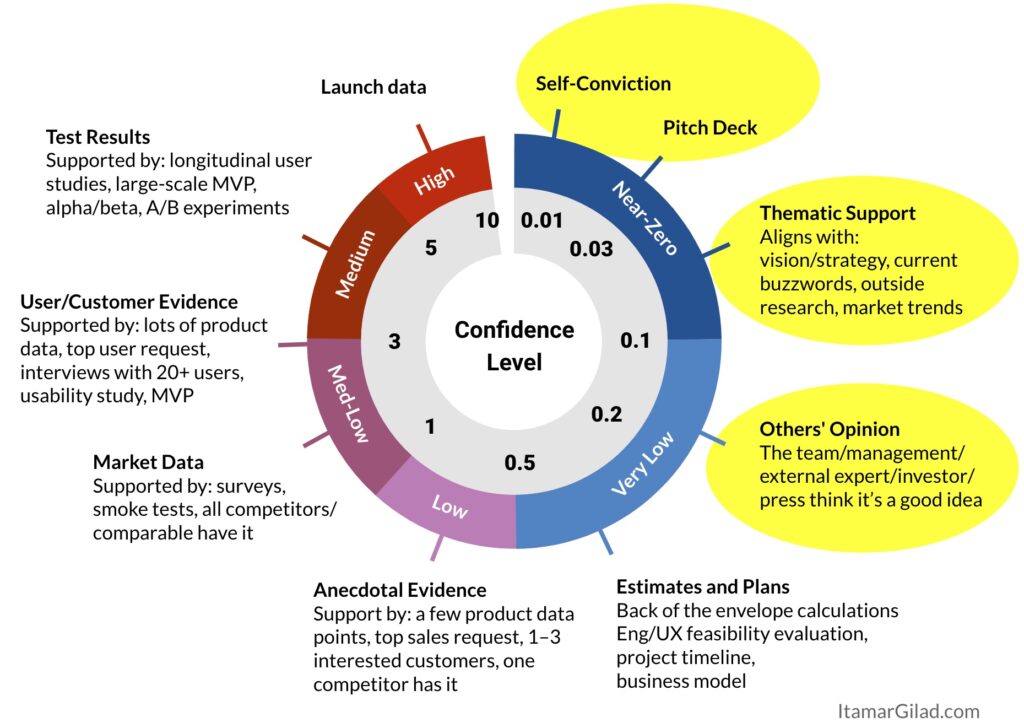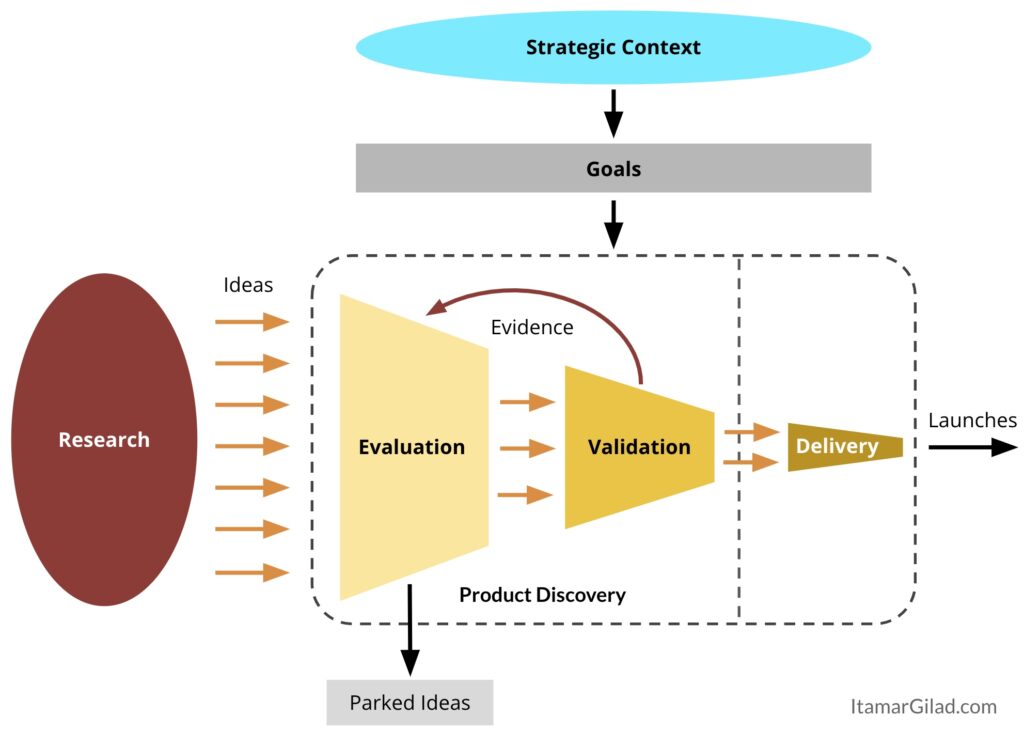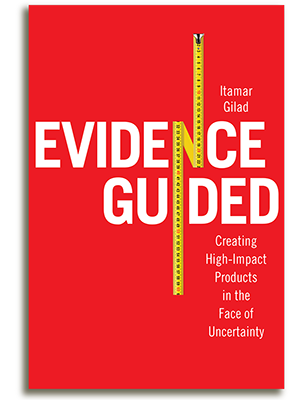Observing tech companies you may notice a broad, disturbing phenomenon: everyone’s hard at work “selling” their product ideas — stakeholders and engineers are selling to product managers, product managers are selling to management, and management is selling to everyone (just listen attentively in the next all-hands meeting). As a product manager I too had to play this game. I remember one job interview, many years ago, when the hiring manager asked me to “sell him my shirt” as a test of my pitching skills. It seems that when it comes to promoting ideas, critical thinking, humility, and evidence are not widely in use, while salesmanship, politics, and hype are the norm.

The underlying reason is clear — product ideas are competing for limited resources. Managers or committees choose the “winning ideas” that will get a spot on the roadmap, and kill everything else. Having your idea (or an idea assigned to you) win is a very big deal. The result is an internal economy that hinges on salesmanship — the better you get at pushing your ideas, the more likely you are to reap the rewards.
A Fundamentally Bad System
As common and natural as this pitch-fund-build-launch system may sound, it’s actually a very bad way to build products that, as will see shortly, creates major negative effects on business results, product value, and company culture. For that reason, in my workshops and coaching sessions we try to unlearn this pattern. Instead, I teach PMs and leaders how to think critically of their product ideas and how to replace pitching competitions with evidence-guided prioritization. I’ll show you this alternative later in the article, but first let’s look at the downsides of the hype economy.
Betting on the Wrong Horses
Roadmap decisions are often made through a combination of sparse data, opinions, consensus, and biases. A skillful presenter can use these to spin a compelling narrative that will sway the people in charge to choose his/her idea. However self-conviction, a compelling pitch-deck, thematic support, and consensus are all very weak forms of evidence — essentially opinions by a different name, as reflected in my Confidence Meter:

Choosing the ideas that are best sold can easily create roadmaps that are full of bad ideas, while good ideas that aren’t as well communicated (or aren’t intuitive) may end up in the graveyard.
Perverse Incentives and Bad Culture
Getting your project approved and funded can lead to big personal rewards: access to more resources, extended scope and visibility, recognition, and promotions. Thus, the hype economy creates perverse incentives to push for your idea (whether it’s the best or not) at the expense of everyone else’s (a zero-sum game). Scott Cook, founder of Intuit, talked about the effect on company culture:
“You don’t have entrepreneurs, you have politicians, because you have to sell. Out of a hundred good ideas, you’ve got to sell your idea. So you build up a society of politicians and salespeople.”
The Lean Startup / Eric Ries
The problem is even stronger in top-down companies where the leaders choose their own ideas, essentially hogging all the innovation. The next step is to sell the project downward and to get people committed to it using a combination of rhetoric, carrots, and sticks. This culture is far from healthy, and people at the middle and the bottom of the hierarchy may get frustrated and mistrustful of the plans.
Success Theatre
Even when your project is underway, the selling cannot stop. As the idea was sold as the next big thing, you must keep projecting a facade of success irrespective of true results. I’ve seen people use impressive mental gymnastics and moving-of-the-goalposts in an attempt to spin failure as success. Some especially crafty operators use the “success” of launching a massive project as a springboard for promotion, then distance themselves from the impending failure by handing-down the project to a report and moving on to something else.
Funders/investors sometimes share the motivation to cover up for their bad investments, and may throw good money after bad in an attempt to rescue the project. For example, during the boom years of zero-interest money, many startups that lacked a viable business model stayed superficially “successful” through an infusion of investment money.
Dishonesty (Faking It)
In extreme cases people may cross the fuzzy line between over-hyping their ideas and flat-out lying about them. This phenomenon is more evident in startups where “fake it before you make it” has become something of a norm. An extreme case in point is Theranos, a med-tech startup that promised to revolutionize blood tests. Over 12 years the company raised more than $700 million and reached a peak valuation of $10 billion, despite having no technology or product to speak of. Theranos was a complete technology failure, but a brilliant success at selling a story that everyone wanted to buy. Eventually the truth broke out and the two founders were found guilty of fraud and sentenced to 11 and 13 years in prison. (If you’re not familiar with the story I highly recommend reading the book Bad Blood).
In my courses we practice implementing evidence-guided development and empowered teams hands-on.
Secure your ticket for the next public workshop or contact me to organize an in-house workshop or keynote for your team.
The Alternative – Evidence-Guided Development
Good product companies try hard to remove hype and salesmanship from product decisions. They use a Fundamentally better system: Evidence-Guided Development.

Strategic Context
High-impact product companies have a clear sense of vision and mission; they identify the most important strategic opportunities or challenges ahead, and they put in place simple guiding principles (for example “focus on the buy-side first”). This strategic context creates a clear and broadly understood direction for the company, and creates a barrier against external and internal forces pushing and pulling it in all directions.
Clear and Concise Goals
Having clear and concise company goals that reflect the most important achievements the company is aiming for this year, further helps boost alignment and eliminates non-productive ideas. This is really where we want to hold the hard discussions and negotiation: what are those 3-5 top priorities that we must pursue and achieve? Once that’s resolved, the rest of the company (for example product teams) can create derived goals, where applicable, but also local goals based on the tactical context. These goals will help defend the team from pressure tactics on the part of stakeholders and managers pushing for their own ideas. If the idea does not contribute to the goal, the team should be allowed to say No.
Research
Basing Ideas off research — user, market, data, competitive, technology — rather than opinions and one-of customer requests, can both enhance the quality of the ideas, and ensure that they come with at least some amount of supporting evidence. That in turn improves the quality of the discussion and brings external realities into the focus of prioritization decisions.
Product Discovery
Product discovery is the art and science of evaluating and validating multiple ideas, before picking the ones we wish to build in full and launch. The name was coined by Marty Cagan, but you can argue that Lean Startup, Design Thinking, and most other forms of modern product development are about product discovery (I offer my own recipe for combining them in my book Evidence-Guided). Product Discovery helps detect and park weak ideas early and cheaply, and maximizes the potential of good ideas. It is inspired by the scientific method, and relies heavily on evidence rather than opinions or showmanship.
Product discovery is the ultimate destroyer of the hype economy, partly because it eliminates the need to hype your ideas. Many more ideas can be accepted into discovery; park/pivot/deliver decisions are made based on evidence rather than how well the idea was presented. It’s a much more honest and transparent system that most people instantly relate to.
Addressing The Core Problem
Hype and salesmanship, pressure tactics, and politics, are not the core problem, but rather symptoms of it. When companies lack a clear sense of direction, and where decisions are made on the basis of opinions, it’s only natural for people to take initiative and fill the void with their own agendas and ideas. Companies that plot their destination clearly, but allow exploration and discovery of the path, are not only able to achieve much more, but they also enjoy a much healthier work culture, one that brings people and departments together around the goals rather than set them apart to pursue their own ideas.
Title image: Wannapik Studio
Join 15,000 product people who receive my articles, tools, and templates in their inbox


